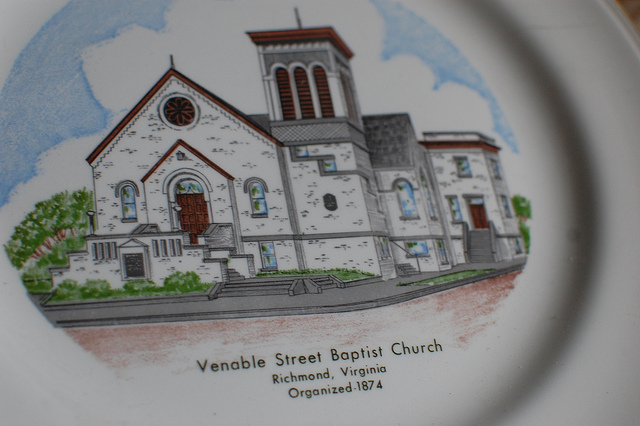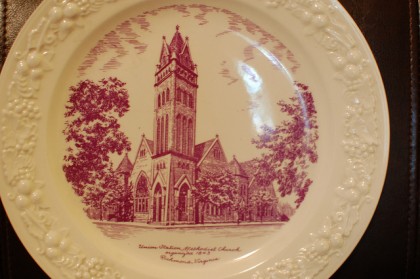RECENT COMMENTS

Commemorative plates from two white-flight churches
These two plates are undated, though both churches were gone from the area by 1954.
With roots as a mission church in 1871 at 17th and Venable Streets, Venable Street Baptist Church was built at 2101 Venable Street in 1891. Great Hope Baptist Church was organized in 1944 and purchased the Church of the Nazarene at 24th and Venable streets from a white congregation. Great Hope later sold this building to Shiloh Baptist Church when they purchased the larger sanctuary from Venable Street Baptist. The text on the back of the plate says that when, “because of the changing population, the church again moves its location”, they moved to Cedar and Ellis (what is now Elkridge Lane and Hartman Street) in Henrico County. That location is now home to the Rising Mt.Zion Baptist Church, itself founded during Reconstruction in the Fulton area.
The Union Station Methodist Church began as a congregation in the 1840s in a new building at 812 North 25th Street. A decade or so later, they moved to another new building at Cedar and 24th Street. This building was demolished in the 1890s and the current building was erected. Union Station Methodist Church, seeking to move, merged with Monument Methodist Church in 1951 and became Reveille Methodist Church. In 1952, the Union Station Methodist Church building was sold to an African-American congregation and became Cedar Street Memorial Baptist Church.








Third Presbyterian has a *somewhat* similar history with our neighborhood. That church was located on Broad Street for nearly a century before departing for the West End. Their website’s account of that decision to leave Church Hill uses better word choices than the two commemorative plates above.
According to their website, “observing the decline of the neighborhood and facing a situation that was believed to hold no future for the growth of the church, the congregation voted in October 1956 to sell the property and undertake a building program on two acres of land on Forest Avenue…”
What distinguishes Third Presbyterian from the two churches above is the recent effort made by their congregation to focus on the restoration and revitalization (both physically and spiritually) of the East End. Third Presbyterian has helped to establish East End Fellowship, a ministry dedicated to racial reconciliation, and also supports CHAT and other worthy programs in the area.
http://www.eastendfellowship.org/
As one of the pastors of Third Presbyterian and also co-pastor of East End Fellowship(along with Don Coleman), I want to acknowledge that at least from what I have been able to discern, Third Pres’ move in 1956 was undoubtedly influenced by the seismic racial shifts that were occurring in the 1950s in Richmond. While the racial reconciliation and justice work we are currently doing through East End Fellowship and other ministries by no means compensates for the way the church contributed to the heritage of systemic racism in Richmond, I personally want to repent of our church’s complicity in our city’s divisions and our failure to take seriously Jesus’ call to peace and restoration. As East End Fellowship we are seeking to take seriously the biblical call to ‘Shalom’, the spiritual/social/economic peace of our city. And I’m grateful to see other pastors and churches in the city and the East End pursuing the same vision.